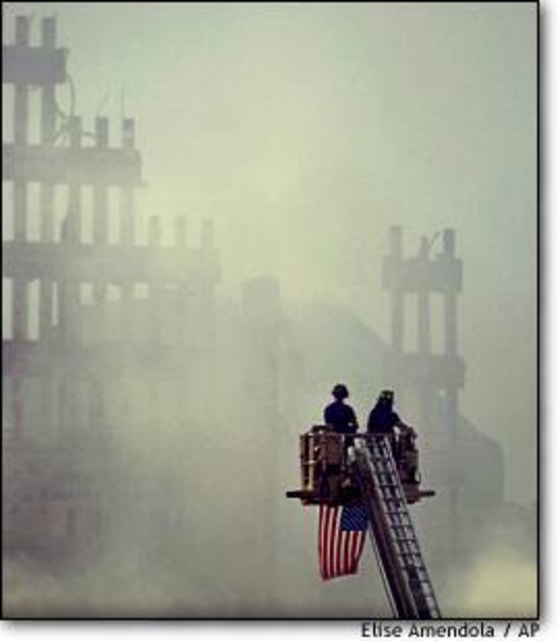Scapegoating is an ugly thing, and having made its share of mistakes on this count (the internment of Japanese-Americans and court martial of Adm. Husband E. Kimmel after Pearl Harbor spring to mind), the United States has been rightly careful in apportioning blame for the stunning domestic vulnerabilities exposed by the Sept. 11 terrorist attacks. There also has been an understandable focus on how to strike back at the groups responsible.
Yet with the American flag no longer flying at half staff, it also is time for some clear thinking about the actions, and inactions, that opened the door to the worst act of terrorism in history. Some of these questions may seem unfair, and may add pain to those who may be suffering enormous personal anguish at the perceived implications of decisions they may or may not have made before the attacks. For instance, how does the United States now deal with Israel? Do we start writing blank checks to Israel in its handling of the Palestinians? Do we stop denouncing Russian brutality in Chechnya or Turkey’s treatment of its Kurds in the name of the “war on terrorism?” Or do we demand that such nations consider the danger the backlash harsh measures often bring? What of the Immigration and Naturalization Service, which knew these terrorists were in the country, but had no process (or basis) for raising the alarm? What blame does the media share in serving up the unrelenting diet of gossip and scandal that has marked American journalism since the end of the Cold War instead of educating Americans in the global realities that underpin the attack?
Three years ago, in this column, I pointed out the irony that it was the Central Intelligence Agency, in part, that taught Osama bin Laden and his network how to fight a superpower. A year later, after the attack on U.S. embassies in East Africa and the USS destroyer Cole in Aden, I asked what, exactly, it was going to take before America’s military actually moved against this man.
Unfortunately, I now have my answer. I take no pleasure in having been right.
With that in mind, here are just three of the many tough questions we should be grappling with:
1. Where was the Air Force?
How can a hijacked aircraft crash into the nerve center of the U.S. military more than a half hour after everyone in the nation’s largest city witnessed two airliners crash into the World Trade Center towers?
So far, there has been no convincing answer to that question, and journalists have not really pressed the issue.
The White House confirmed that Bush authorized the shooting down of the fourth hijacked plane that had veered off-course, but that its crash in western Pennsylvania did not result from any military action. Given the lapses of the past two weeks, one is inclined to believe that had they managed to do so, they would be bragging about the fact right now.
As a witness to the attacks, I can completely understand how the first and even the second aircraft that smashed into the towers might have failed to set off the alarm bells of a sleepy, peacetime nation that has grown far too accustomed to the idea that it strides across the world stage with impunity. The New York attacks were a shock and surprise to the system that should ensure that no repeat attack of the same kind will ever be possible. But the Pentagon — 39 minutes later? And this from a military that claims it will soon be able to shoot down multiple missiles launched at the nation? It defies reason.
Clearly, the Federal Aviation Administration made tremendous errors, and the U.S. Air Defense system was asleep at the wheel, at least in the bureaucratic sense. I’m sure they tracked every move that day. But if President Bush’s command really is needed to shoot down an aircraft-turned-missile heading for one of our cities, then the “system” is useless.
In fact, past experience shows it did not have to be so. Consider the reactions of the FAA and air defense units to another recent event. On Oct. 25, 1999, a Learjet carrying golfer Payne Stewart took off from Orlando, Fla. on a routine flight.
Less than an hour later, after ground controllers had tried repeatedly but failed to get a response from the plane’s flight crew, the FAA requested that an Air Force F-16 be scrambled to the side of the aircraft to determine whether anyone on board was still alive. The assumption, apparently correct, was that the plane was on automatic pilot and that something had gone wrong on board, killing all the passengers.

The aircraft was tracked by Air Defense radar as it streaked north toward Canada. It eventually crashed into an unoccupied field in South Dakota, but the air force had been ready to blast it from the skies if it had, say, veered toward Fargo or Minneapolis.
All this for a Learjet.
2. Why didn’t engineers understand the implications of a jet-fueled fire in the towers?
There was a time when architects and building engineers conceded what they did not know as readily as they bragged about what they did understand. At the end of 19th century and the beginning of the 20th, as the scale of the bridges and towers man could build increased exponentially, engineers took fewer chances. Look at the older gems of New York’s shattered skyline and you find bridges and towers that were over-engineered by 20 times and more. In effect, the mathematical side of engineering was too primitive to construct anything as tall as a skyscraper that wasn’t built five or ten times stronger than it had to be.
The Empire State Building, the Brooklyn and George Washington bridges, the Holland and Lincoln tunnels, are built to withstand many times the stress necessary — 80 times the required stress, in the case of the Brooklyn Bridge. By the 1970s, when the World Trade Center towers were built, architects and engineers designed with a precision that allowed them to build things only exactly as strong as they needed to be. This saved enormous amounts of money, of course. By the 1990s, computer models and other advances allowed for even greater precision — not only in structural design, but in accounting for the effects of wind or earthquakes or, even, airliner impacts.
Harry Seidler, an Australian architect who designed several of the world’s largest towers, visited the World Trade Center during its construction in the early 1970s and was shocked.
“I was extremely surprised at the time that the construction was so delicate,” he told an Austrian newspaper, Die Kleine Zeitung, on Monday. “It was the lightest I have ever seen.” Seidler said the tower’s design would never have won approval in Europe or Australia.
Why then, were engineers incapable of predicting the horrific results of high-temperature fires with similar precision? Reports suggest that it began to dawn on the engineers working with the rescue crews outside the towers that they might collapse if the temperatures inside the tower, which were designed to contain such fires, continued at 2,000 degrees or higher. The towers were supported by huge steel columns running through their centers. The impact of the airliners likely compromised these seriously, and the weight of the floors above then shifted to the less robust outer support beams. Eventually, the fire melted these outer beams until they collapsed. Each beam was designed only to support the weight of those above them. When suddenly that weight doubled and tripled and quadrupled as each successive floor collapsed, implosion became inevitable.
It all seems too obvious now. Going forward, structural engineers and architects need to search their souls and hard drives for the implications. An under-reported story on that tragic day is the number of people who actually DID get out. That number would have been higher if our engineers and architects had been a bit more humble, and our developers a bit less concerned with the cost of building materials.
3. Why is Afghanistan NOT among the seven countries listed by the U.S. State Department as “state sponsors of terrorism”?
The answer to this question is a bit complicated by the infernal bureaucracy of American diplomacy, but it’s worth understanding. The short-term answer is this: Afghanistan’s Taliban regime is not recognized by the U.S. as the government of that country, and therefore is not regarded as the leader of a “state.” This, of course, is a bit like denying the rain because you don’t much like getting wet.
To its credit, the United States tried to use the fact that Afghanistan was left off the list to do some good, in the simple, genuine meaning of that word. Last year, for instance, the United States authorized aid to the estimated 2 million Afghan refugees, the vast majority of whom care no more for Osama bin Laden than Americans do. The U.S. also authorized payments to Afghan farmers who agreed, with the tacit consent of the Taliban, to forego poppy cultivation (the raw material of heroin) for other, less profitable crops. Behind the scenes, the United States tried to use these small kindnesses as leverage to obtain help from the Taliban in keeping bin Laden from launching attacks from his Afghan hideout.
Deals with the devil, as I’ve said before, are sometimes necessary. But in this case, we courted the devil and he gave us hell. The policy always was rooted in the timidity of the United States when it came to doing something truly effective against enemies abroad — measures that would require more than a cruise missile launched from the comfy confines of a Navy cruiser. In the past, when I’ve pointed out the moral bankruptcy of wars like the one “fought” over Kosovo, I’ve been bombarded by mail from the mothers and fathers of military personnel. Send your own children, they said, not mine.
My response was and continues to be this: our military has no draft. Those voluntarily donning its uniform are tremendously honorable and brave, and I count among them many friends. But no one who joins up should kid themselves about the job they’re signing on to do. The Army may have slick recruiting campaigns that make is sound like your son or daughter will spend their next four years playing computer games and earning extra money for college. Don’t believe it. War is hell, even if we’ve spent the years since Vietnam trying to sanitize it. Now war has come to our shores, in the form of the devil we know. Prepare yourself.
Michael Moran is on assignment in London.
